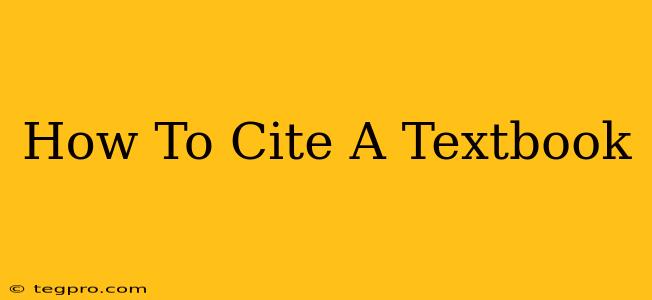Citing your sources correctly is crucial for academic integrity. It shows respect for the original authors and avoids plagiarism. This comprehensive guide will walk you through how to cite a textbook, covering the most common citation styles: MLA, APA, and Chicago. We'll break down the essential elements and provide examples to help you master textbook citation.
Understanding Citation Styles
Before diving into the specifics, it's important to understand that different academic disciplines favor different citation styles. These styles dictate the order and formatting of information presented in your citations and bibliography. The most prevalent styles include:
- MLA (Modern Language Association): Commonly used in humanities disciplines like literature, languages, and cultural studies.
- APA (American Psychological Association): Predominantly used in social sciences, psychology, education, and business.
- Chicago/Turabian: Used in history, the arts, and other fields. It has two main styles: Notes and Bibliography and Author-Date.
Choosing the correct style is vital; using the wrong style can lead to penalties. Always check your assignment guidelines or style guide for the required citation format.
Essential Elements for Textbook Citations
Regardless of the citation style, certain key pieces of information are consistently needed to accurately cite a textbook:
-
Author(s): The person or people who wrote the textbook. List them in the order they appear on the title page. Use the last name, followed by a comma and the first initial (or initials). If there are more than three authors, you can often shorten it to the first author's name followed by "et al." (meaning "and others").
-
Year of Publication: The year the textbook was published.
-
Title of Textbook: The full title of the textbook, usually italicized.
-
Edition (if applicable): Indicate the edition if it's not the first. For example, "2nd ed." or "3rd edition."
-
Publisher: The name of the publishing company.
-
Location of Publisher: Usually the city and state (or country) where the publisher is located.
How to Cite a Textbook in Different Styles
Let's look at how to cite a textbook using the three main styles:
MLA Citation of a Textbook
MLA citations are typically placed within the text (parenthetical citations) and then a "Works Cited" page lists all sources.
Example:
(Author's Last Name Page Number).
For example: (Smith 123).
Works Cited Page Entry:
Smith, John. Title of Textbook. Publisher, Year.
APA Citation of a Textbook
APA uses in-text citations that include the author's last name and year of publication. A reference list at the end of the document provides full bibliographic information.
Example:
(Author's Last Name, Year, Page Number).
For example: (Smith, 2023, p. 123).
Reference List Entry:
Smith, J. (Year). Title of Textbook. Publisher.
Chicago/Turabian Citation of a Textbook
Chicago style has two main systems: Notes and Bibliography, and Author-Date. Both require a bibliography at the end of your work.
Notes and Bibliography Style Example (Note):
- John Smith, Title of Textbook (Publisher, Year), 123.
Bibliography Entry:
Smith, John. Title of Textbook. Publisher, Year.
Author-Date Style Example (In-text citation):
(Smith, Year, 123)
Bibliography Entry:
Smith, John. Title of Textbook. Publisher, Year.
Tips for Accurate Textbook Citations
- Double-check all information: Carefully verify the author's name, title, year, publisher, etc. against the textbook's title page and copyright page.
- Use a citation manager: Tools like Zotero or Mendeley can help you organize your sources and generate citations in different styles automatically.
- Consult a style guide: Always refer to the most up-to-date style guide for your chosen citation style for specific formatting rules.
Mastering textbook citations may seem daunting at first, but with practice and attention to detail, it becomes a straightforward process. By following these guidelines, you can confidently and accurately cite your sources, demonstrating your academic integrity and strengthening your research.

